Single-Shot Three-Dimensional Reconstruction Using Grid Pattern-Based Structured-Light Vision Method
Abstract
1. Introduction
2. Methods
2.1. System Model
2.2. Extraction of the Grid Stripe Features
- (1)
- (2)
- (3)
- After that, the center points of the regions can be easily obtained and sorted to be the markers (Figure 3d).
- (4)
2.3. Calibration Procedures
3. Experiments and Discussion
3.1. System Calibration
3.2. Measurement Verification
4. Conclusions
Author Contributions
Funding
Institutional Review Board Statement
Informed Consent Statement
Data Availability Statement
Conflicts of Interest
References
- Cao, J.; Li, C.; Li, C.; Zhang, X.; Tu, D. High-reflectivity surface measurement in structured-light technique by using a transparent screen. Measurement 2022, 196, 111273. [Google Scholar] [CrossRef]
- Wang, H.; Ma, J.; Yang, H.; Sun, F.; Wei, Y.; Wang, L. Development of three-dimensional pavement texture measurement technique using surface structured light projection. Measurement 2021, 185, 110003. [Google Scholar] [CrossRef]
- Yang, G.; Wang, Y. Three-dimensional measurement of precise shaft parts based on line structured light and deep learning. Measurement 2022, 191, 110837. [Google Scholar] [CrossRef]
- Zhang, S. High-speed 3D shape measurement with structured light methods: A review. Opt. Lasers Eng. 2018, 106, 119–131. [Google Scholar] [CrossRef]
- Stempin, J.; Tausendfreund, A.; Stöbener, D.; Fischer, A. Roughness measurements with polychromatic speckles on tilted surfaces. Nanomanufacturing Metrol. 2021, 4, 237–246. [Google Scholar] [CrossRef]
- Wang, Z. Review of real-time three-dimensional shape measurement techniques. Measurement 2020, 156, 107624. [Google Scholar] [CrossRef]
- Li, R.; Li, F.; Niu, Y.; Shi, G.; Yang, L.; Xie, X. Maximum a posteriori-based depth sensing with a single-shot maze pattern. Opt. Express 2017, 25, 25332–25352. [Google Scholar] [CrossRef]
- Li, F.; Shang, X.; Tao, Q.; Zhang, T.; Shi, G.; Niu, Y. Single-shot depth sensing with pseudo two-dimensional sequence coded discrete binary pattern. IEEE Sens. J. 2021, 21, 11075–11083. [Google Scholar] [CrossRef]
- Pan, X.; Liu, Z. High-accuracy calibration of line-structured light vision sensor by correction of image deviation. Opt. Express 2019, 27, 4364–4385. [Google Scholar] [CrossRef]
- Li, W.; Hou, D.; Luo, Z.; Mao, X. 3D measurement system based on divergent multi-line structured light projection, its accuracy analysis. Optik 2021, 231, 166396. [Google Scholar] [CrossRef]
- Lu, X.; Wu, Q.; Huang, H. Calibration based on ray-tracing for multi-line structured light projection system. Opt. Express 2019, 27, 35884–35894. [Google Scholar] [CrossRef] [PubMed]
- Salvi, J.; Fernandez, S.; Pribanic, T.; Llado, X. A state of the art in structured light patterns for surface profilometry. Pattern Recognit. 2010, 43, 2666–2680. [Google Scholar] [CrossRef]
- Yin, W.; Feng, S.; Tao, T.; Huang, L.; Trusiak, M.; Chen, Q.; Zuo, C. High-speed 3D shape measurement using the optimized composite fringe patterns and stereo-assisted structured light system. Opt. Express 2019, 27, 2411–2431. [Google Scholar] [CrossRef] [PubMed]
- Zuo, C.; Feng, S.; Huang, L.; Tao, T.; Yin, W.; Chen, Q. Phase shifting algorithms for fringe projection profilometry: A review. Opt. Lasers Eng. 2018, 109, 23–59. [Google Scholar] [CrossRef]
- Vuylsteke, P.; Oosterlinck, A. Range image acquisition with a single binary-encoded light pattern. IEEE Trans. Pattern Anal. Mach. Intell. 1990, 12, 148–164. [Google Scholar] [CrossRef]
- Shi, G.; Yang, L.; Li, F.; Niu, Y.; Li, R.; Gao, Z.; Xie, X. Square wave encoded fringe patterns for high accuracy depth sensing. Appl. Opt. 2015, 54, 3796–3804. [Google Scholar] [CrossRef]
- Wang, L.; Chen, Y.; Han, X.; Fu, Y.; Zhong, K.; Jiang, G. A 3D shape measurement method based on novel segmented quantization phase coding. Opt. Lasers Eng. 2018, 113, 62–70. [Google Scholar] [CrossRef]
- Shoji, E.; Komiya, A.; Okajima, J.; Kubo, M.; Tsukada, T. Three-step phase-shifting imaging ellipsometry to measure nanofilm thickness profiles. Opt. Lasers Eng. 2019, 112, 145–150. [Google Scholar] [CrossRef]
- Fu, B.; Li, F.; Zhang, T.; Jiang, J.; Li, Q.; Tao, Q.; Niu, Y. Single-shot colored speckle pattern for high accuracy depth sensing. IEEE Sens. J. 2019, 19, 7591–7597. [Google Scholar] [CrossRef]
- Pagès, J.; Salvi, J.; Collewet, C.; Forest, J. Optimised de bruijn patterns for one-shot shape acquisition. Image Vis. Comput. 2005, 23, 707–720. [Google Scholar] [CrossRef]
- Albitar, C.; Graebling, P.; Doignon, C. Robust structured light coding for 3D reconstruction. In Proceedings of the 2007 IEEE 11th International Conference on Computer Vision, Rio De Janeiro, Brazil, 14–21 October 2007; pp. 1–6. [Google Scholar]
- Li, Q.; Li, F.; Shi, G.; Gao, S.; Li, R.; Yang, L.; Xie, X. One-shot depth acquisition with a random binary pattern. Appl. Opt. 2014, 53, 7095–7102. [Google Scholar] [CrossRef] [PubMed]
- Lavoie, P.; Ionescu, D.; Petriu, E. 3D object model recovery from 2D images using structured light. IEEE Trans. Instrum. Meas. 2004, 53, 437–443. [Google Scholar] [CrossRef]
- Shi, G.; Li, R.; Li, F.; Niu, Y.; Yang, L. Depth sensing with coding-free pattern based on topological constraint. J. Vis. Commun. Image Represent. 2018, 55, 229–242. [Google Scholar] [CrossRef]
- Salvi, J.; Batlle, J.; Mouaddib, E. A robust-coded pattern projection for dynamic 3D scene measurement. Pattern Recognit. Lett. 1998, 19, 1055–1065. [Google Scholar] [CrossRef]
- Sagawa, R.; Furukawa, R.; Kawasaki, H. Dense 3D reconstruction from high frame-rate video using a static grid pattern. IEEE Trans. Pattern Anal. Mach. Intell. 2014, 36, 1733–1747. [Google Scholar] [CrossRef]
- Je, C.; Lee, S.W.; Park, R.-H. High-contrast color-stripe pattern for rapid structured-light range imaging. In Proceedings of the Computer Vision—ECCV 2004, Prague, Czech Republic, 11–14 May 2004; Springer: Berlin/Heidelberg, Germany; pp. 95–107. [Google Scholar] [CrossRef]
- Jason, G.Z. Rainbow three-dimensional camera: New concept of high-speed three-dimensional vision systems. Opt. Eng. 1996, 35, 376–383. [Google Scholar]
- Ulusoy, A.O.; Calakli, F.; Taubin, G. Robust one-shot 3D scanning using loopy belief propagation. In Proceedings of the 2010 IEEE Computer Society Conference on Computer Vision and Pattern Recognition—Workshops, San Francisco, CA, USA, 13–18 June 2010; pp. 15–22. [Google Scholar]
- Ulusoy, A.O.; Calakli, F.; Taubin, G. One-shot scanning using De Bruijn spaced grids. In Proceedings of the 2009 IEEE 12th International Conference on Computer Vision Workshops, ICCV Workshops, Kyoto, Japan, 27 September–4 October 2009; pp. 1786–1792. [Google Scholar]
- Furukawa, R.; Kawasaki, H.; Sagawa, R.; Yagi, Y. Shape from grid pattern based on coplanarity constraints for one-shot scanning. IPSJ Trans. Comput. Vis. Appl. 2009, 1, 139–157. [Google Scholar] [CrossRef][Green Version]
- Cui, Y.; Zhou, F.; Wang, Y.; Liu, L.; Gao, H. Precise calibration of binocular vision system used for vision measurement. Opt. Express 2014, 22, 9134–9149. [Google Scholar] [CrossRef]
- Wang, X.; Zhu, Z.; Zhou, F.; Zhang, F. Complete calibration of a structured light stripe vision sensor through a single cylindrical target. Opt. Lasers Eng. 2020, 131, 106096. [Google Scholar] [CrossRef]
- Liu, X.; Liu, Z.; Duan, G.; Cheng, J.; Jiang, X.; Tan, J. Precise and robust binocular camera calibration based on multiple constraints. Appl. Opt. 2018, 57, 5130–5140. [Google Scholar] [CrossRef]
- Qi, L.; Zhang, Y.; Zhang, X.; Wang, S.; Xie, F. Statistical behavior analysis and precision optimization for the laser stripe center detector based on Steger’s algorithm. Opt. Express 2013, 21, 13442–13449. [Google Scholar] [CrossRef] [PubMed]
- He, L.; Wu, S.; Wu, C. Robust laser stripe extraction for three-dimensional reconstruction based on a cross-structured light sensor. Appl. Opt. 2017, 56, 823–832. [Google Scholar] [CrossRef] [PubMed]
- Yang, F. Binocular measurement method using grid structured light. Chin. J. Lasers 2021, 48, 64–76. [Google Scholar]
- Shi, J. Good features to track. In Proceedings of the 1994 IEEE Conference on Computer Vision and Pattern Recognition, Seattle, WA, USA, 21–23 June 1994; pp. 593–600. [Google Scholar]
- Hou, J.; Gao, H.; Li, X. Dsets-DBSCAN: A parameter-free clustering algorithm. IEEE Trans. Image Process. 2016, 25, 3182–3193. [Google Scholar] [CrossRef] [PubMed]
- Zhang, Z. A flexible new technique for camera calibration. IEEE Trans. Pattern Anal. Mach. Intell. 2000, 22, 1330–1334. [Google Scholar] [CrossRef]
- Albarelli, A.; Rodolà, E.; Torsello, A. Robust camera calibration using inaccurate targets. In Proceedings of the British Machine Vision Conference, Aberystwyth, UK, 31 August–3 September 2010. [Google Scholar]

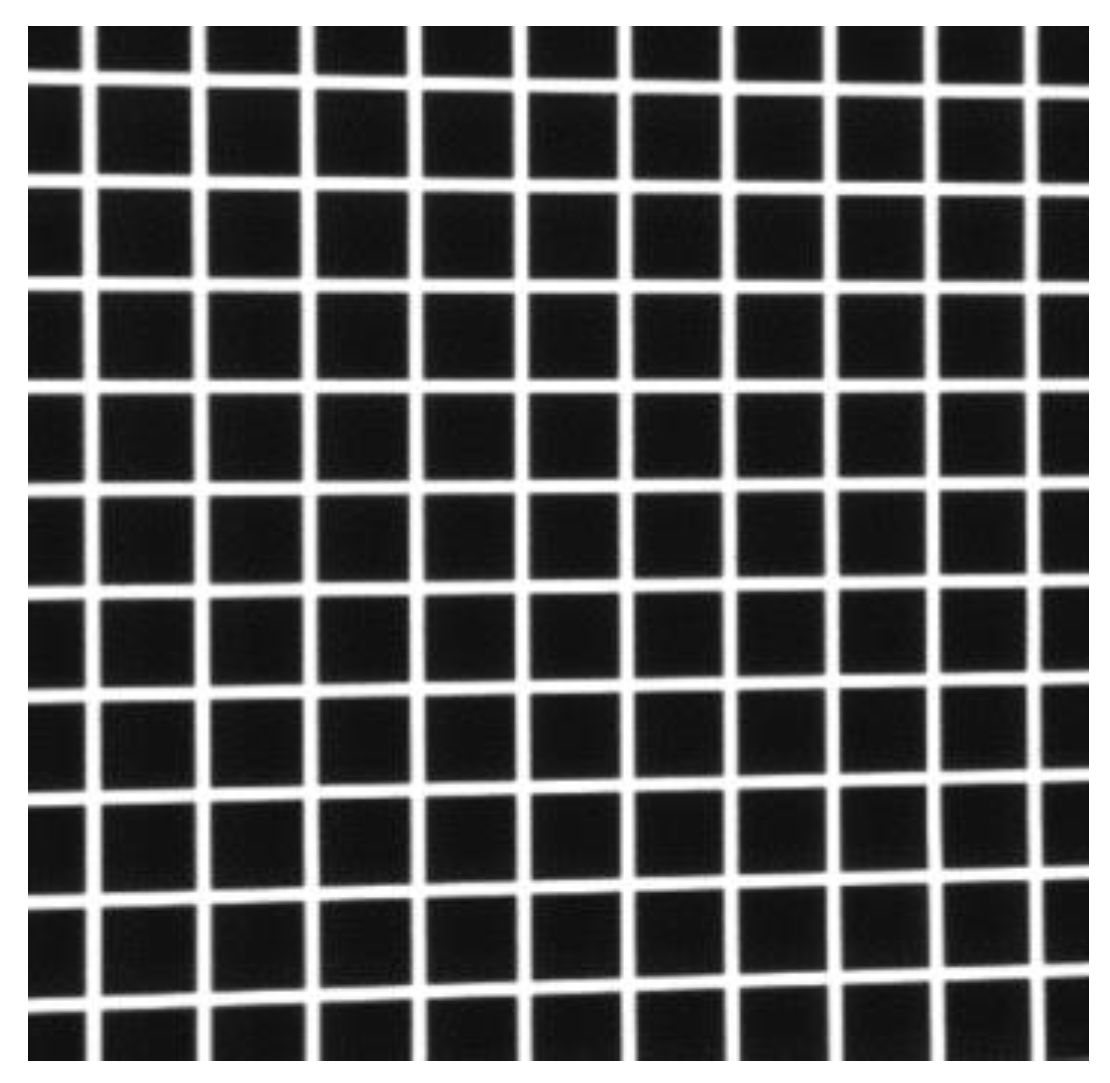
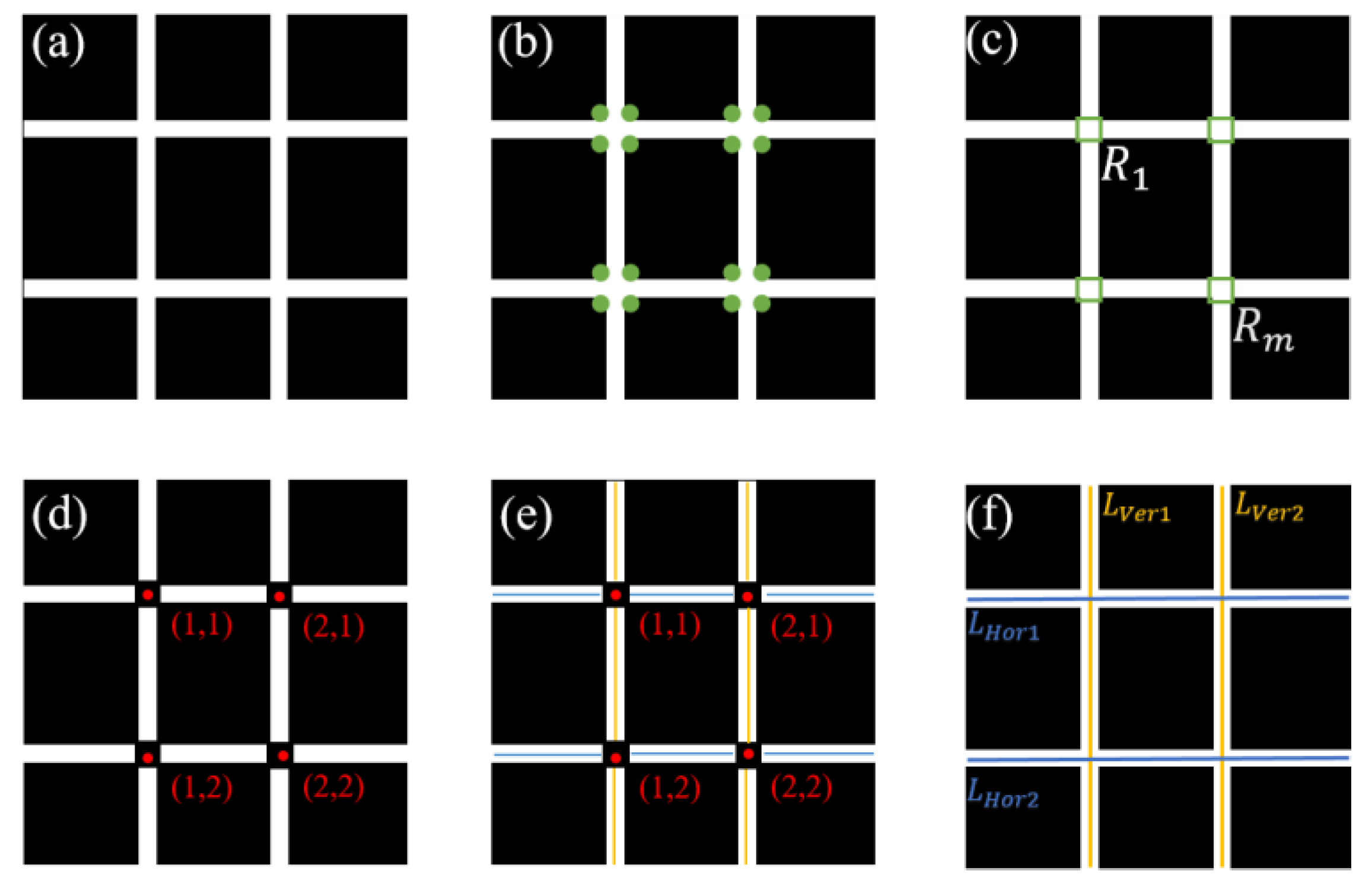





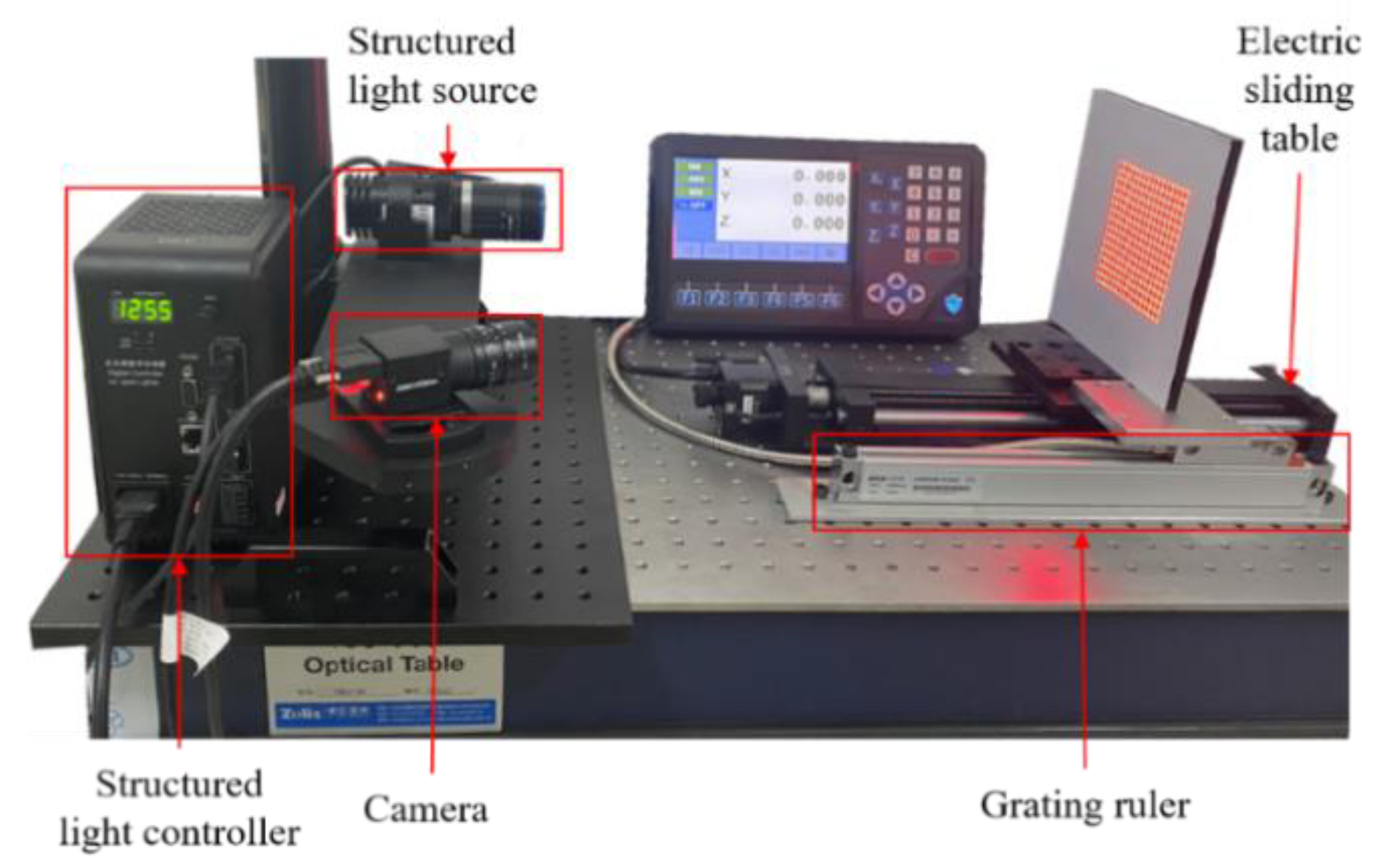
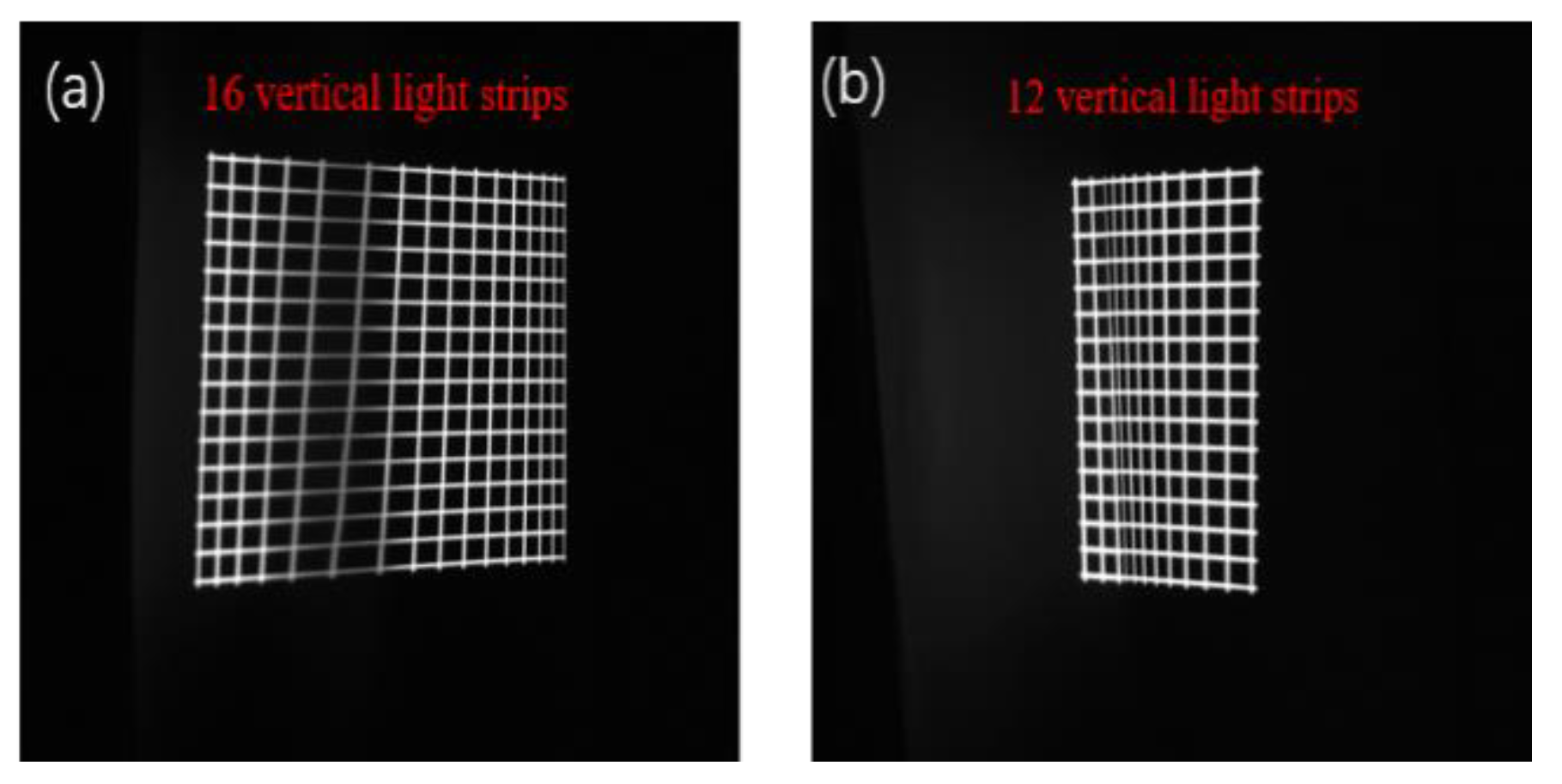
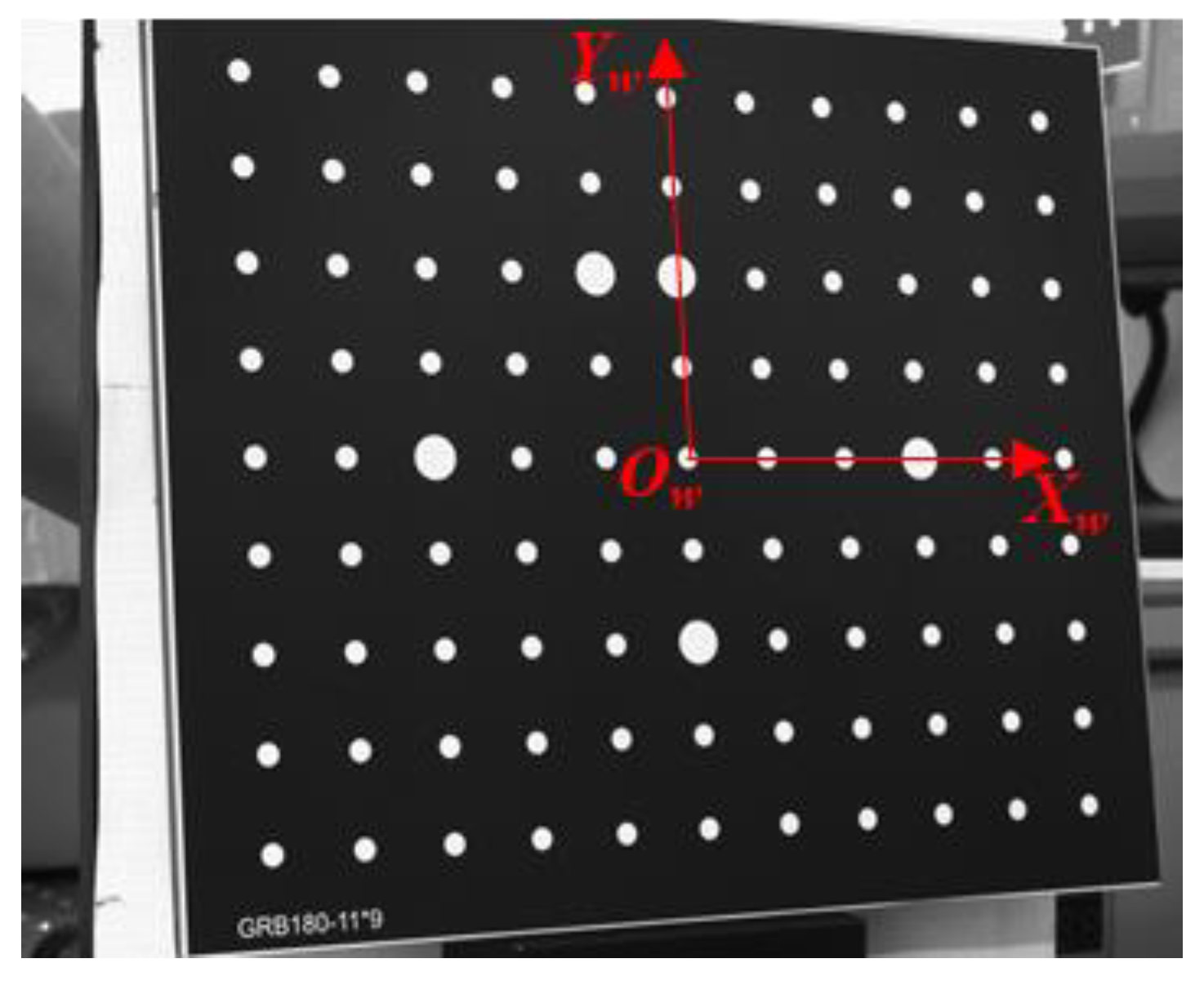
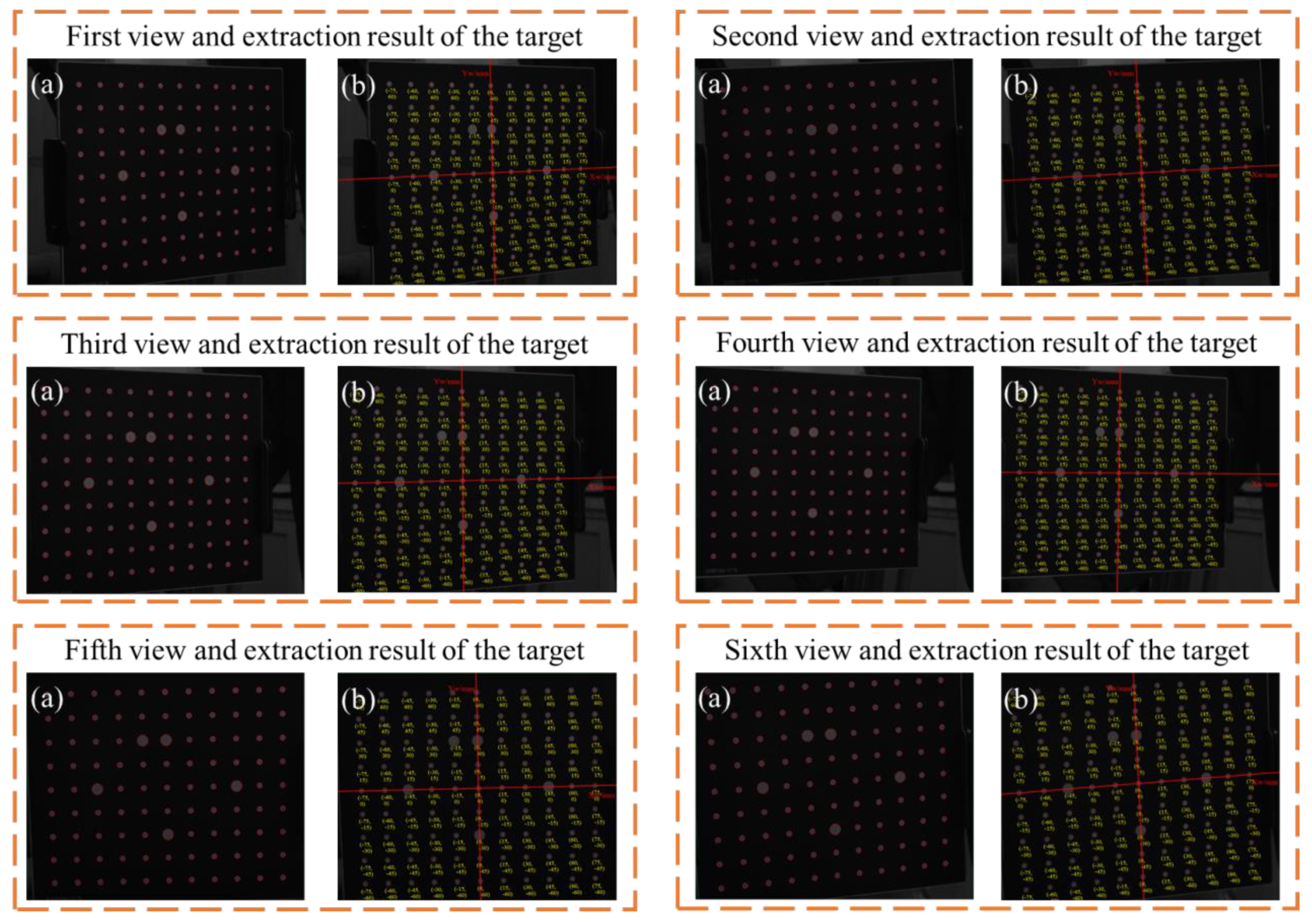
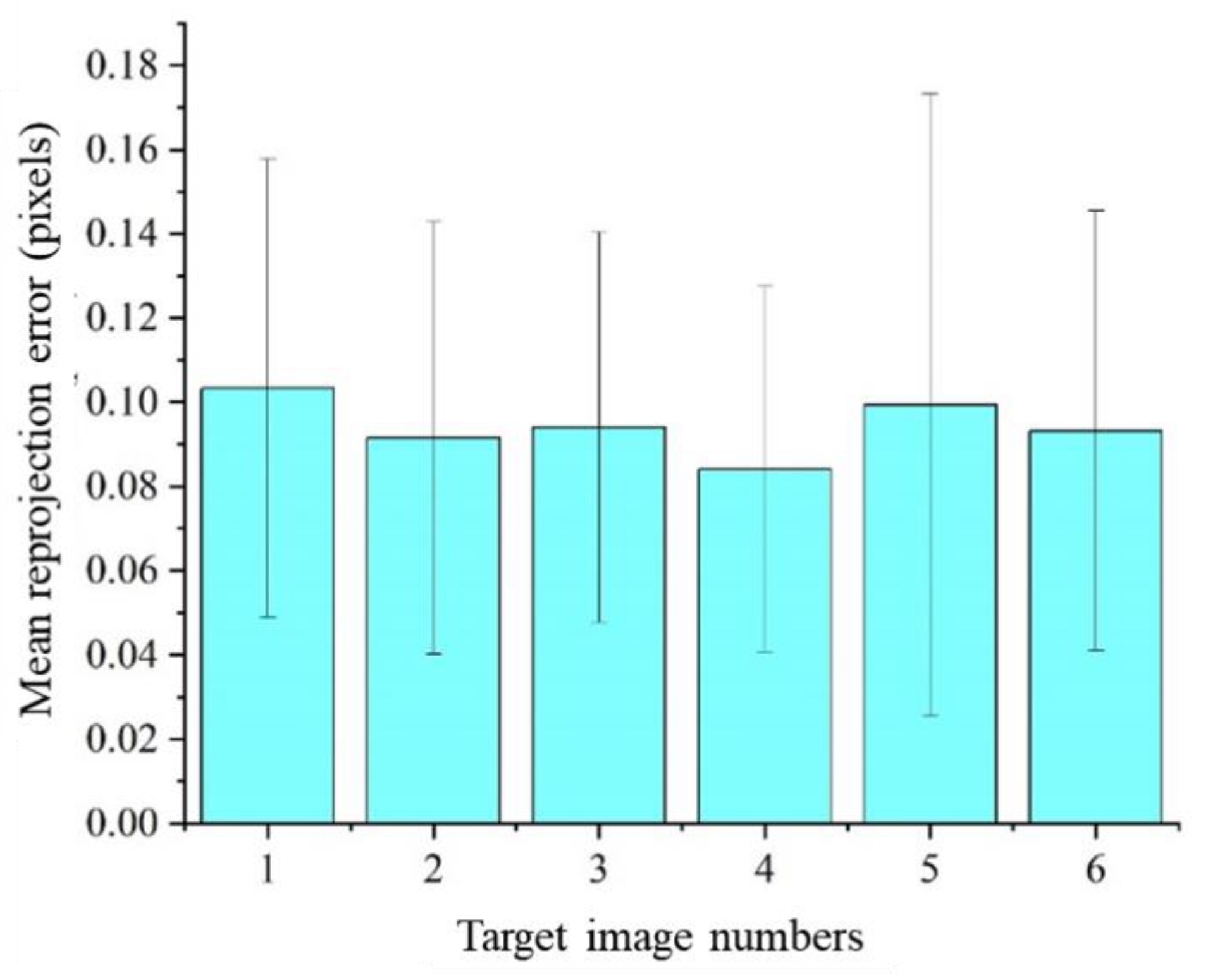


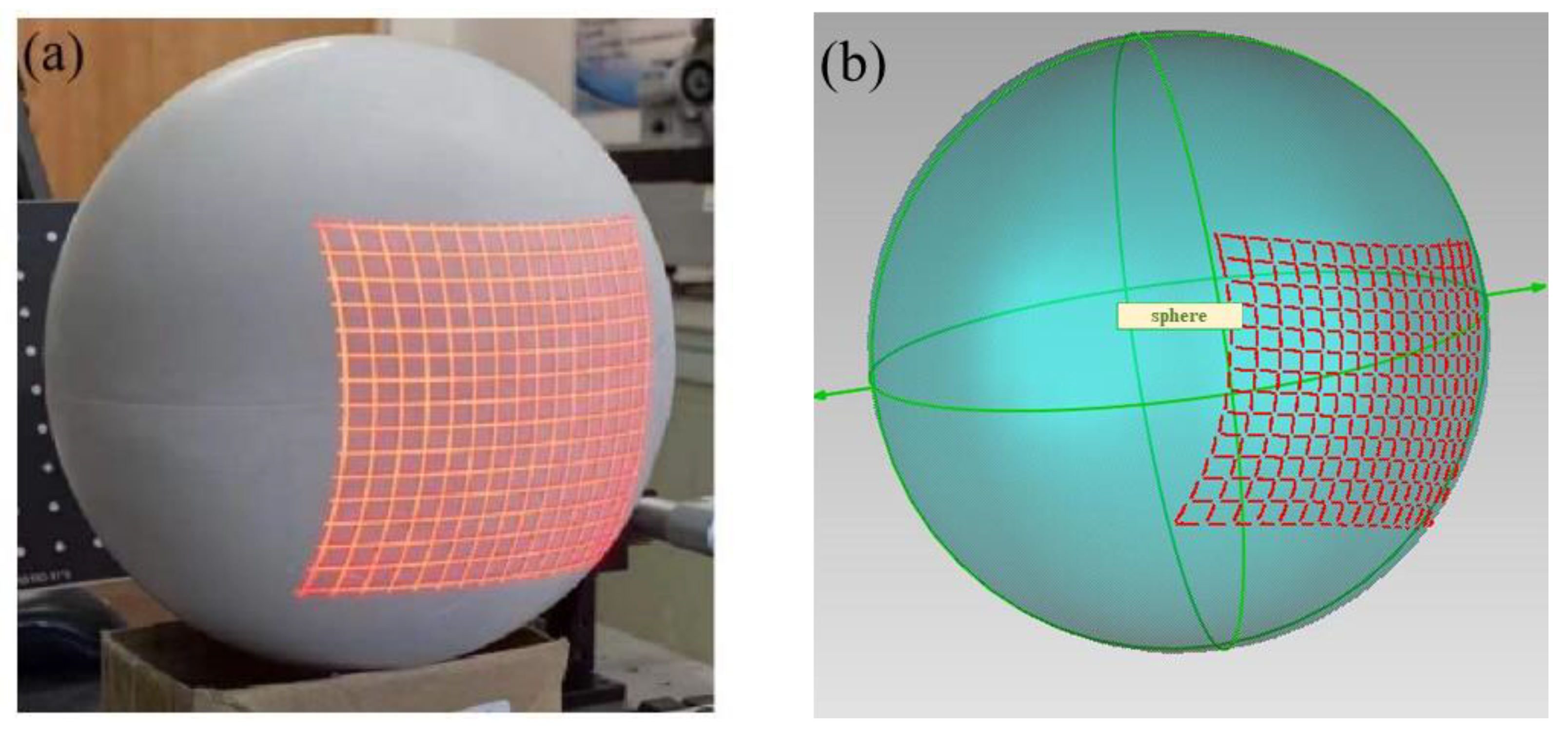

| Specifications | Values |
|---|---|
| Boundary dimensions (mm) | 180 × 150 |
| Circle diameter (mm) | 7 (L), 3.5 (S) |
| Center distance (mm) | 15 |
| Array number | 11 × 9 |
| Precision (mm) | ±0.01 |
| Parameters | Results |
|---|---|
| fx, fy (pixel) | 3354.0982, 3354.8173 |
| u0, v0 (pixel) | 697.163, 478.755 |
| k1, k2 | −0.041, −1.344 |
| p1, p2 | −0.00039, −0.00041 |
| Pose Views | rveci | Ti |
|---|---|---|
| 1 | [−3.020, 0.046, −0.760] | [1.616, 5.987, 514.204] |
| 2 | [−3.124, 0.083, −0.186] | [−8.074, 5.674, 511.550] |
| 3 | [−3.048, 0.017, −0.677] | [−18.359, 5.856, 500.676] |
| 4 | [−3.073, −0.015, −0.548] | [−25.7326, 0.505, 549.236] |
| 5 | [−3.021, 0.031, −0.023] | [−7.029, 5.590, 469.236] |
| 6 | [−2.990, 0.909, −0.355] | [−9.006, 2.654, 464.551] |
| ID | [Aver, Bver, Cver, Dver] | [AHor, BHor, CHor, DHor] |
|---|---|---|
| 1 | [0.807, 0.009, 0.59, −224.019] | [−0.041, 0.996, 0.807, 6.870] |
| 2 | [0.814, 0.009, 0.579, −224.667] | [−0.035, 0.997, 0.071, 6.137] |
| 3 | [0.821, 0.008, 0.569, −225.443] | [0.029, −0.998, −0.061, −5.225] |
| 4 | [0.829, 0.008, 0.558, −225.711] | [−0.023, 0.999, 0.05, 4.704] |
| 5 | [0.836, 0.007, 0.548, −226.566] | [−0.016, 0.999, 0.039, 4.195] |
| 6 | [0.843, 0.007, 0.537, −226.901] | [−0.01, 0.999, 0.028, 3.694] |
| 7 | [0.849, 0.007, 0.527, −227.53] | [−0.003, 0.999, 0.017, 3.244] |
| 8 | [0.856, 0.006, 0.516, −227.949] | [0.004, 1.000, 0.006, 2.82] |
| 9 | [0.863, 0.005, 0.505, −228.439] | [−0.01, −0.999, 0.005, −2.447] |
| 10 | [0.869, 0.006, 0.493, −228.702] | [−0.017, −0.999, −0.015, 1.838] |
| 11 | [0.875, 0.004, 0.483, −229.223] | [0.023, −0.999, −0.028, 1.98] |
| 12 | [0.881, 0.004, 0.471, −229.522] | [0.029, 0.998, −0.037, 1.143] |
| 13 | [0.897, 0.004, 0.46, −229.653] | [−0.036, −0.998, 0.049, −1.109] |
| 14 | [0.893, 0.004, 0.449, −230.287] | [0.043, 0.997, −0.059, 0.085] |
| 15 | [0.898, 0.003, 0.438, −230.369] | [0.048, 0.996, −0.069, −0.395] |
| 16 | [0.903, 0.003, 0.428, −231.273] | [−0.054, −0.995, 0.078, 1.719] |
| Ground Truth (mm) | Measurement Results (mm) | Errors (mm) | Relative Errors |
|---|---|---|---|
| 3.862 | 3.869 | 0.007 | 0.181% |
| 6.838 | 6.824 | −0.014 | −0.205% |
| 9.045 | 8.969 | −0.076 | −0.840% |
| 12.524 | 12.475 | −0.049 | −0.391% |
| 15.601 | 15.514 | −0.087 | −0.558% |
| 50.190 | 20.039 | −0.151 | −0.748% |
| 24.573 | 24.558 | −0.015 | −0.061% |
| 28.892 | 28.879 | −0.013 | −0.045% |
| 32.511 | 32.550 | 0.039 | 0.120% |
| 61.571 | 61.748 | 0.177 | 0.287% |
| 113.541 | 113.880 | 0.339 | 0.299% |
| Nominal Radius (mm) | Our Approach (mm) | D455 (mm) |
|---|---|---|
| 85.000 | 84.652 | 88.937 |
Publisher’s Note: MDPI stays neutral with regard to jurisdictional claims in published maps and institutional affiliations. |
© 2022 by the authors. Licensee MDPI, Basel, Switzerland. This article is an open access article distributed under the terms and conditions of the Creative Commons Attribution (CC BY) license (https://creativecommons.org/licenses/by/4.0/).
Share and Cite
Liu, B.; Yang, F.; Huang, Y.; Zhang, Y.; Wu, G. Single-Shot Three-Dimensional Reconstruction Using Grid Pattern-Based Structured-Light Vision Method. Appl. Sci. 2022, 12, 10602. https://doi.org/10.3390/app122010602
Liu B, Yang F, Huang Y, Zhang Y, Wu G. Single-Shot Three-Dimensional Reconstruction Using Grid Pattern-Based Structured-Light Vision Method. Applied Sciences. 2022; 12(20):10602. https://doi.org/10.3390/app122010602
Chicago/Turabian StyleLiu, Bin, Fan Yang, Yixuan Huang, Ye Zhang, and Guanhao Wu. 2022. "Single-Shot Three-Dimensional Reconstruction Using Grid Pattern-Based Structured-Light Vision Method" Applied Sciences 12, no. 20: 10602. https://doi.org/10.3390/app122010602
APA StyleLiu, B., Yang, F., Huang, Y., Zhang, Y., & Wu, G. (2022). Single-Shot Three-Dimensional Reconstruction Using Grid Pattern-Based Structured-Light Vision Method. Applied Sciences, 12(20), 10602. https://doi.org/10.3390/app122010602







